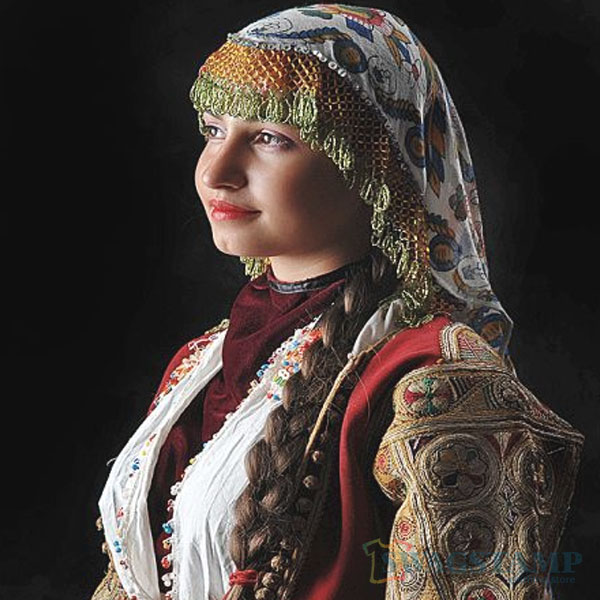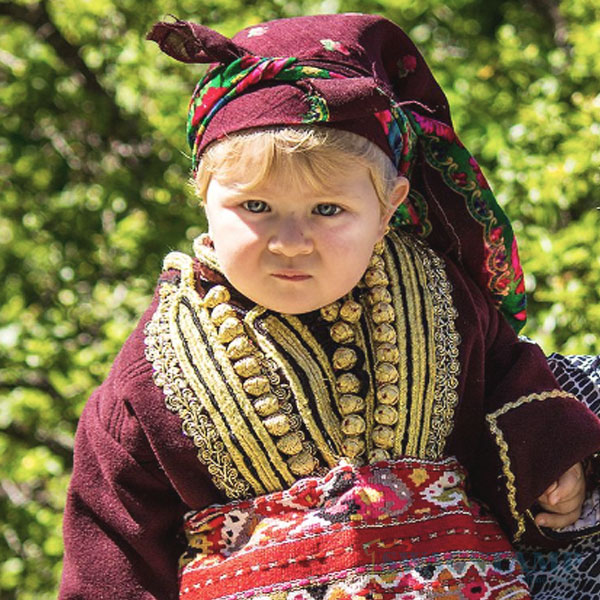Blog
Discover the Beauty of Macedonian Traditional Clothing: A Cultural Journey
Macedonia is a country with a rich cultural heritage, and one of the most fascinating aspects of this heritage is Macedonian traditional clothing.
Although beautiful and full of cultural significance, wearing traditional Macedonian clothing can be difficult for modern people due to its complexity and weight. The traditional clothing consists of many layers, making it uncomfortable for everyday wear. Additionally, the handmade nature of the clothing results in high prices that might not always be feasible for people on a budget.
Despite the challenges associated with wearing Macedonian traditional clothing, it remains an important part of the country’s history and culture. Historically, people would wear this type of clothing for special occasions like weddings, baptisms, and other religious celebrations. Wearing traditional clothing was a way to celebrate their cultural heritage and to show respect to their ancestors. Today, national events such as Independence Day and state holidays still feature traditional Macedonian clothing.
In conclusion, Macedonian traditional clothing is an essential aspect of the country’s culture and history. Although it might be difficult to wear it daily, it remains a symbol of the nation’s identity and a powerful way to honor the past.
“Macedonian Traditional Clothing” ~ bbaz
Macedonian Traditional Clothing
Macedonian traditional clothing is the attire worn by the people of North Macedonian during ceremonies and special events. The traditional dress has a rich history dating back to prehistoric times. It is a reflection of cultural identity, social status and gender roles. In this article, we will explore the different elements of the Macedonian traditional clothing.
Embroidery
Embroidery is an essential feature in the design of Macedonian traditional clothing. It is a unique and intricate form of art that reflects the skill and creativity of the artisans. When I visited Macedonia, I was fascinated by the embroidery on the traditional clothing. The patterns and colors used were vibrant and made the clothes look more elegant.
Vests
The vest is an essential element of the Macedonian traditional male attire. The vest is intricately embroidered with the patterns often representing local flora and fauna. The vest is worn over the shirt and under the jacket. The vest is usually made of wool or silk.
Shirt
The shirt is another crucial component of the Macedonian traditional men’s wear. The shirt is white and long-sleeved, made of linen or cotton. The shirt is embroidered along the sleeves, neck and chest.
Jacket
The jacket is the outerwear worn on top of the vest and the shirt. The jacket comes in various colors, designs, and fabrics. The most common type of jacket is the black or brown felt jacket called “Jeke”. It is adorned with ornaments and embroidery.
Barmen
Barmen is a head cover worn by Macedonian male. Barmen is a cylindrical shaped headgear made of woven wool. The headgear is commonly associated with the traditional Macedonian costume.
Apron
The apron is the essential component in Macedonian traditional female attire. The apron is made of cotton or silk and embroidered with patterns of flowers, birds and geometric shapes. The apron is worn over the long skirt and blouse.
Skirt
The skirt is usually made of wool or linen material. The skirt is long and has an A-line shape. It may also have embroidery or borders that match the apron.
Blouse
The blouse is a long-sleeved shirt usually made of cotton. The blouse is also adorned with embroidery on the sleeves, neck, and chest
Belts
Belts are accessories worn by both men and women. The belts may be plain or decorated with embroidery. The belts serve to adjust the size of the garments and also add style to the look.
Footwear
Footwear is an essential element of the Macedonian traditional dress. The shoes are made of leather and often adorned with embroidery. Women’s shoes have a low heel, while men’s shoes are flat.In conclusion, Macedonian traditional clothing is a symbol of Macedonian culture and heritage. It is a beautiful and unique attire that reflects the creativity and skill of its artisans. The combination of vibrant colors, intricate embroidery, and diverse fabrics make this attire a sight to behold.
 Macedonian Traditional Clothing: A Timeless Treasure
Macedonian Traditional Clothing: A Timeless Treasure
Throughout history, Macedonian Traditional Clothing has been a representation of the country’s rich culture and heritage. The traditional dress is an ensemble of various garments that are handmade with embroidery, lace, and intricate details that reflect each region’s unique traditions. The traditional clothing is worn during celebrations and festivals, and it is an essential aspect of the Macedonian way of life. It combines elegance, comfort, and practicality while celebrating the country’s customs and values. Macedonian Traditional Clothing is not just clothing; it is a timeless treasure passed from generation to generation.
The Target of Macedonian Traditional Clothing
I still remember seeing women in my grandmother’s village dressed in traditional outfits. Their colorful dresses, aprons, and scarfs caught my attention as a child. The elderly women walked proudly down the village streets, and their clothing was a celebration of their identity and heritage. Macedonian Traditional Clothing targets everyone who honors and celebrates the country’s rich cultural legacy. It epitomizes the profound connection between Macedonians, their traditions, and their land. Whether you are attending a wedding, a formal occasion or working in the fields, Macedonian Traditional Clothing is a compelling symbol of national pride and identity.My aunt once told me a story about how she made a traditional shirt for her husband years ago. She recounted how she had to buy handmade fabric from a local market, measure and cut the fabric, and hand-stitch every piece together. The entire process took weeks, but the satisfaction of creating something with her own hands was worth it. This story illustrates the value and significance of Macedonian Traditional Clothing.Macedonian Traditional Clothing has several elements, including the Šara dress, the folk costume from the Povardarie region, and the traditional attire from the Pirin region. Some of these elements include a pleated skirt, embroidered vest, and white blouses decorated with lacework. Many Macedonian women also wear scarfs or headgear decorated with coins, beads, and shells. Such designs exhibit the cultural diversity present in various regions.In conclusion, the Macedonian Traditional Clothing is an exceptional aspect of this country’s identity that represents its unparalleled heritage and culture. It is a testament to the country’s enduring connection to its land and people. If you ever get the opportunity to see a Macedonian dressed in traditional clothing or attend a Macedonian celebration where traditional clothes are worn, cherish this experience. It is a unique chance to witness the beauty and richness of the Macedonian culture.
Have you ever wondered about Macedonian Traditional Clothing? Here we will answer some of the most common questions about this topic.
What is Macedonian Traditional Clothing?
Macedonian Traditional Clothing refers to the clothing worn by the people of North Macedonia, which varies depending on the region and occasion. Generally, it consists of colorful and embroidered garments made from wool, silk or cotton.
What are some typical pieces of Macedonian Traditional Clothing?
Typical pieces of Macedonian Traditional Clothing include the opinga (shoe), fustanella (skirt), jelek (waistcoat) and dolama (trousers). Women often wear a headdress called a krpanija, while men traditionally wear a kapa (cap).
When is Macedonian Traditional Clothing worn?
Macedonian Traditional Clothing is typically worn at weddings, festivals, religious celebrations and other special occasions. It is also sometimes worn as part of national costume during folk dance performances.
What is the significance of the embroidery on Macedonian Traditional Clothing?
The embroidery on Macedonian Traditional Clothing often represents symbols of good fortune, such as birds, flowers and stars. It is also used to showcase the skill and creativity of the person who made the garment.
Conclusion of Macedonian Traditional Clothing
Macedonian Traditional Clothing is an important aspect of the country’s cultural heritage. Its colorful and intricate designs reflect the creativity and traditions of the Macedonian people, and are often worn with pride during special occasions. By preserving and promoting these garments, we can keep the rich history and culture of North Macedonia alive for generations to come.
Macedonian Traditional Clothing: A Cultural Heritage
Macedonian traditional clothing is a reflection of the country’s rich history and cultural heritage. It consists of unique garments that vary by region and exhibit colorful patterns and embroidery. Macedonian traditional clothing was mainly worn during significant events such as weddings, religious ceremonies, and folk festivals. The clothing also represents a symbol of identity for the Macedonian people.The Macedonian traditional dress for women is called “Sukmana, which consists of a long-sleeved shirt, vest, apron, and skirt. The dress is made of wool or cotton, and the color varies according to the region. The dress’s embroidery is usually in floral or geometric patterns and is hand-sewn by the women of the family. Men’s traditional clothing includes a white cotton shirt, leather boots, trousers, and a vest or coat.

The Target of Macedonian Traditional Clothing
As a young Macedonian girl, I remember watching my grandmother sew her traditional dress, Sukmana. She would sit for hours, carefully stitching each pattern with a needle and thread. I was fascinated by the beauty of the dress and its intricate design. When my grandmother put on her dress, she transformed into a graceful and elegant lady, representing the pride of her heritage.Macedonian traditional clothing aimed to preserve the country’s culture and customs. It represented the Macedonian people’s identity and their connection to their land and traditions. The clothing was not only a fashion statement but also a way of communicating the wearer’s status, social position, and gender. Macedonian traditional clothing was a symbol of unity and respect for the country’s history and cultural heritage.In conclusion, Macedonian traditional clothing is a vital part of the country’s cultural heritage. It represents the Macedonian people’s identity, traditions, and customs. The clothing is unique and beautiful, reflecting the country’s history and diversity. Wearing traditional clothing is not only a fashion statement but also a way of preserving the Macedonian culture and passing it down to future generations.

